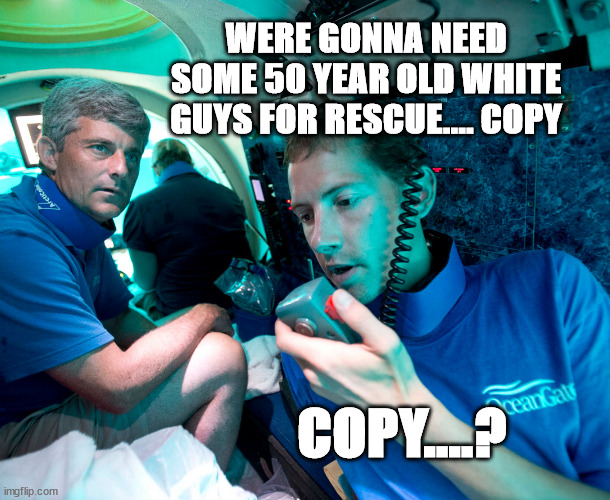

Accidents happen. And consider that the company CEO was on this particiular dive, so he apparently didn’t fear Titan’s safety. Besides, that earlier claim was from 2018. What did they change or fix since then?
By FAR the best take on the fatal Titan sub fiasco.
[Yes, fatal.]
Skip the rest, this is the best, by an actual subject matter expert.
https://www.youtube.com/watch?v=4dka29FSZac
[Titan’s hull “showed signs of cyclic fatigue.”]
Yikes
I recall reading that the United States Coast Guard and its entry into the Marine Safety realm occurred during the period when steamship boilers were routinely exploding. They started inspecting steamship boilers and found out that square boilers soldered together or welded or whatever affixment they use were not anywhere near the strength nor could they avert the pressures adequately before they blow. So as a result the advent of spherical boilers became the safest design feature tested.
It looks like a turd. Too bad it wasn’t a floater.
They are so out of business.
Stockton Rush, unlike Bruce Ismay, had the courage of his convictions.
The novella — "The Wreck of the Titan: Or, Futility" by Morgan Robertson — boasted startling similarities to the sinking of the Titanic.The story follows the fictional ocean liner Titan, which ultimately hits an iceberg in the North Atlantic and sinks. And the name and circumstances of the plot aren't the only details that fit the real-life disaster — the History of the Net breaks down a number of striking connections between the real-life and fictional ships.
Like the Titanic, the Titan was described as the largest ship afloat at the time. In fact, the sizes and lengths of the ships are quite close, as well as the speed at which they crash into the iceberg. Both liners have a dangerous shortage of lifeboats. In the story, the Titan was both dubbed "unsinkable," and proceeded to sink on a cold April night.
The Titan's sinking resulted in the deaths of all 2,500 people on board, save 13. Over 1,500 people died on the Titanic, while 705 survivors made it out.
After the sinking of the Titanic, the book was reissued and Roberston was labeled a clairvoyant. He said that he simply was knowledgeable about maritime operations saying, "I know what I'm writing about, that's all."
I’m not a fan of carbon fiber. I’ve had seen it in boats, kayaks, bicycles fail without warning. Yes, it is strong and light, but when it fails it shatters. This whole enterprise, sounds like something my friends and I would do, when we ten.
Not good
Interesting - what kind of hull was it using, then?
;^)
Strange looking casket, but it holds five.
From Ocean Gate’s website:
“Real-Time Health Monitoring
The most significant innovation is the proprietary real-time hull health monitoring (RTM) system. Titan is the only manned submersible to employ an integrated real-time health monitoring system. Utilizing co-located acoustic sensors and strain gauges throughout the pressure boundary, the RTM system makes it possible to analyze the effects of changing pressure on the vessel as the submersible dives deeper, and accurately assess the integrity of the structure. This onboard health analysis monitoring system provides early warning detection for the pilot with enough time to arrest the descent and safely return to surface.”
This is about a silly a risk mitigation strategy as I have ever seen. In industry, subject to peer review and some certifying authority such as ABS or DNV I would never expect it to pass muster. Especially not with a material known to fail suddenly, catastrophically and completely such as a composite.
I am an engineer with more than 40 years of oilfield high pressure containment experience and 30 years of experience in subsea facilities including design and construction of large subsea systems. The environment is unforgiving and destructive. Things often don’t work as theory, calculation and design expect they will. That is often with steel, metal-to-metal seals and elastomer seals. Composites are a material we simply steered clear of because of the vague failure conditions and that there is generally no fatigue life, it just fails when it wears out. Just look at one stress-strain plot for a composite and see what I mean.
In steel construction we have spent decades and huge sums studying fracture mechanics, it is still a black art. One associate of mine suggested that without a wide safety margin in the predicted fracture failure cycle number it was like measuring with a micrometer just how close you could get to a mule before it would kick the living hell out of you.
Sub-safe is a phrase we used and understood in subsea construction. We learned it from the Navy guys we hired to help us learn from their experience. To us it meant that if you saw a risk you had to run it to ground until it was either invalidated or solved. You can accept nothing else. Nothing is fail-safe it is only as good as you can make it and that does not accept half-measures or compromise.
Sometimes it is a good idea to listen to the reservations and experience of 50 year-old white guys.
I would say, “rest in peace a-hole” but that wouldn’t be nice would it?
